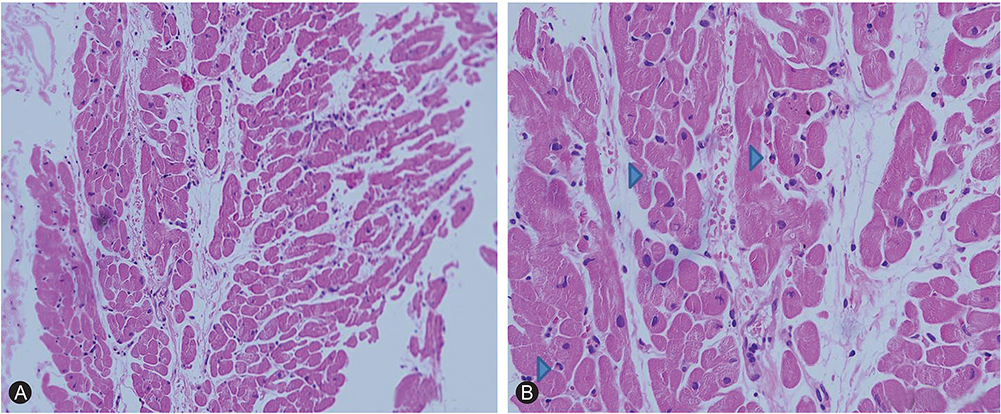Asia Pac Allergy.
2015 Apr;5(2):123-127. 10.5415/apallergy.2015.5.2.123.
Eosinophilic myocarditis: case series and literature review
- Affiliations
-
- 1Department of Internal Medicine, Seoul National University Bundang Hospital, Seongnam 463-707, Korea. addchang@snu.ac.kr
- 2Department of Internal Medicine, Seoul National University College of Medicine, Seoul 110-799, Korea.
- 3Seoul National University Medical Research Center, Seoul National University College of Medicine, Seoul 110-799, Korea.
- KMID: 2397059
- DOI: http://doi.org/10.5415/apallergy.2015.5.2.123
Abstract
- Eosinophilic myocarditis is a condition resulting from various eosinophilic diseases, including helminth infection, drug hypersensitivity, systemic vasculitis or idiopathic hypereosinophilic syndromes. Clinical manifestations of eosinophilic myocarditis may vary from early necrosis to endomyocardial fibrosis. Eosinophilic myocarditis is one of the most fatal complications of hypereosinophilia. However, eosinophilic myocarditis has been rarely reported in the literature, particularly in Asia Pacific regions, reflecting the under-recognition of the disease among clinicians. Early recognition is crucial for improving clinical outcomes of eosinophilic myocarditis. Early administration of systemic corticosteroid is necessary in eosinophilic myocarditis regardless of underlying causes, as delayed treatment may result in fatal outcomes. In addition, differential diagnoses of underlying causes for eosinophilia are necessary to improve long-term outcomes.
MeSH Terms
Figure
Cited by 1 articles
-
In this issue of Asia Pacific allergy
Constance H. Katelaris
Asia Pac Allergy. 2015;5(2):57-58. doi: 10.5415/apallergy.2015.5.2.57.
Reference
-
1. Weller PF, Bubley GJ. The idiopathic hypereosinophilic syndrome. Blood. 1994; 83:2759–2779.
Article2. Ginsberg F, Parrillo JE. Eosinophilic myocarditis. Heart Fail Clin. 2005; 1:419–429.
Article3. Al Ali AM, Straatman LP, Allard MF, Ignaszewski AP. Eosinophilic myocarditis: case series and review of literature. Can J Cardiol. 2006; 22:1233–1237.
Article4. Assa'ad AH, Spicer RL, Nelson DP, Zimmermann N, Rothenberg ME. Hypereosinophilic syndromes. Chem Immunol. 2000; 76:208–229.5. Amini R, Nielsen C. Eosinophilic myocarditis mimicking acute coronary syndrome secondary to idiopathic hypereosinophilic syndrome: a case report. J Med Case Rep. 2010; 4:40.
Article6. Burke AP, Saenger J, Mullick F, Virmani R. Hypersensitivity myocarditis. Arch Pathol Lab Med. 1991; 115:764–769.7. Chang YS, Son JW, Lee SR, Park JK, Cho SH, Min KU, Kim YY. Are Churg-Strauss syndrome and idiopathic hypereosinophilic syndrome in the same spectrum?: a case with overlapping features. J Asthma Allergy Clin Immunol. 1999; 19:208–218.8. Churg A. Recent advances in the diagnosis of Churg-Strauss syndrome. Mod Pathol. 2001; 14:1284–1293.
Article9. Cools J, DeAngelo DJ, Gotlib J, Stover EH, Legare RD, Cortes J, Kutok J, Clark J, Galinsky I, Griffin JD, Cross NC, Tefferi A, Malone J, Alam R, Schrier SL, Schmid J, Rose M, Vandenberghe P, Verhoef G, Boogaerts M, Wlodarska I, Kantarjian H, Marynen P, Coutre SE, Stone R, Gilliland DG. A tyrosine kinase created by fusion of the PDGFRA and FIP1L1 genes as a therapeutic target of imatinib in idiopathic hypereosinophilic syndrome. N Engl J Med. 2003; 348:1201–1214.10. Park HY, Lee SU, Huh S, Kong Y, Magnaval JF. A seroepidemiological survey for toxocariasis in apparently healthy residents in Gangwon-do, Korea. Korean J Parasitol. 2002; 40:113–117.
Article11. Kang SY, Kang MK, Kim MY, Lee SY, Kim TW, Lee SH, Kim SH, Kang HR, Park HW, Chang YS, Kim SS, Cho SH, Min KU. A case of severe hypereosinophilia caused by toxocara infection after ingestion of raw ostrich liver. Korean J Asthma Allergy Clin Immunol. 2011; 31:144–147.12. Japanese Circulation Society Task Force Committee on Acute and Chronic Myocarditis. Guidelines for diagnosis and treatment of myocarditis (JCS 2009) [Internet]. Tokyo: Japanese Circulation Society;cited 2015 Mar 10. Available from: http://www.j-circ.or.jp/guideline/pdf/JCS2009_izumi_h.pdf.13. Arima M, Kanoh T, Kawano Y, Oigawa T, Yamagami S, Matsuda S. Serum levels of eosinophil cationic protein in patients with eosinophilic myocarditis. Int J Cardiol. 2002; 84:97–99.
Article14. Aggarwal A, Bergin P, Jessup P, Kaye D. Hypersensitivity myocarditis presenting as cardiogenic shock. J Heart Lung Transplant. 2001; 20:1241–1244.
Article
- Full Text Links
- Actions
-
Cited
- CITED
-
- Close
- Share
- Similar articles
-
- Eosinophilic Myocarditis Associated with Hypereosinophilia
- A Case of Eosinophilic Myocarditis associated with Hypereosinophilia showing Myocardial Edema
- Immunoglobulin G4-Related Myocarditis with Eosinophilic Infiltration: A Case Report
- Native T1 Mapping Demonstrating Apical Thrombi in Eosinophilic Myocarditis Associated with Churg-Strauss Syndrome
- Eosinophilic Myocarditis-Associated Toxocariasis


